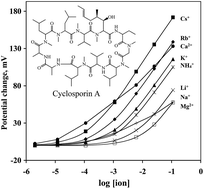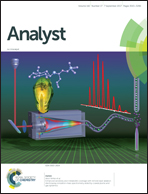Correlating the potentiometric selectivity of cyclosporin-based electrodes with binding patterns obtained from electrospray ionization-mass spectrometry†
Abstract
Electrospray ionization mass spectrometry ESI-MS is a powerful technique for the characterization of macromolecules and their noncovalent binding with guest ions. We herein evaluate the feasibility of using ESI-MS as a screening tool for predicting potentiometric selectivities of ionophores. Ion-selective electrodes based on the cyclic peptide, cyclosporin A, were developed, and their potentiometric selectivity pattern was evaluated. Optimized electrodes demonstrated near-Nernstian slopes with micromolar detection limits toward calcium. ESI-MS and ESI-MS/MS were employed to determine the relative association strengths of cyclosporin A with various cations. The observed MS intensities of ion–ionophore complexes correlate favorably with the potentiometric selectivity pattern that was demonstrated by cyclosporin-based electrodes. This correlation was found to hold true for other established ionophores, such as valinomycin and benzo-18-crown-6. Taken together, these experiments demonstrate that mass spectrometry could be used to predict the selectivity patterns of new ionophores for potentiometric and optical ion sensors. Further, this approach could be useful in screening mixtures or libraries of newly-synthesized compounds to identify selective ionophores.



 Please wait while we load your content...
Please wait while we load your content...